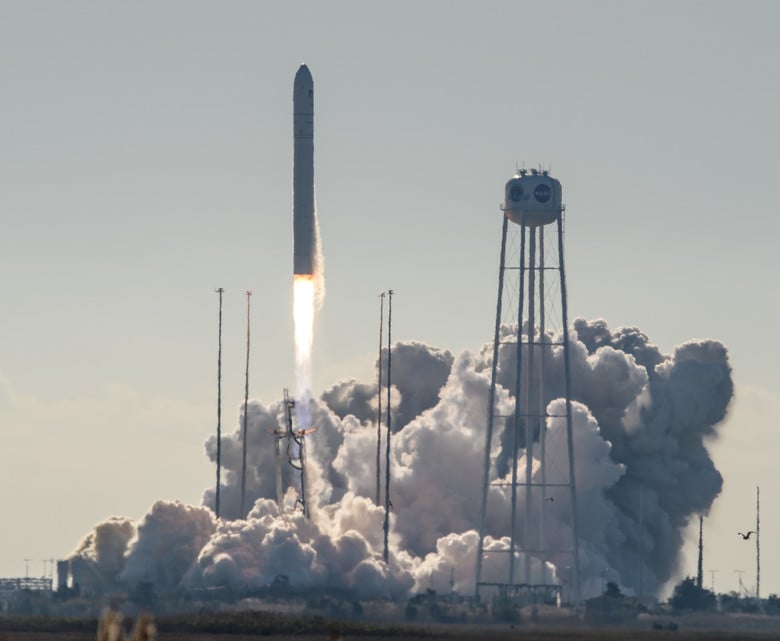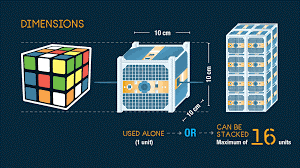
The Northrop Grumman Antares rocket, with Cygnus resupply spacecraft onboard.
WASHINGTON: The Air Force’s ground-breaking Rogue CubeSats will launch from the International Space Station in early 2020 to test new short-wave infrared (SWIR) sensors that can see through smoke and haze, as well as process the gathered imagery.
“Data provided to the Air Force will help in investigating potential uses of the capability and as a pathfinder for ingesting LEO data into existing processing algorithms,” SMC said.
The two satellites, according to Air Force Space and Missile Systems Center’s Development Corps, carry both visible-light and infrared sensors, as well as a high-speed laser communications downlink. In particular, the experiment will help to establish proof of concept for the new SWIR sensor as a potential capability for future mission applications.
SWIR sensors are special. They can see through smoke and haze night and day. They can detect, and differentiate, among types of gas and chemicals on the surface (allowing users to discriminate wood from plastic, for example.) SWIR sensors also can detect invisible laser beams.
SWIR cameras based on Indium Gallium Arsenide (InGaAS) require no cryogenic cooling, which means they are lightweight and so optimal for small satellites. Further, because SWIR is a reflected energy like visible light, it can identify objects at night without additional illumination.
Such sensors are currently in vogue as potential enablers of a number of commercial and military capabilities, from SWIR LIDAR for autonomous vehicles to Earth imaging to surveillance cameras to telecommunications to weapons guidance. A number of commercial satellite imaging firms, such as Maxar Technologies, already are using SWIR sensors.
Rogue Alpha and Beta, build by the Aerospace Corporation, are 3-unit CubeSats (CubeSats are structured as modular cubes) about the size of a shoebox.  They were launched to the ISS on Nov. 2 by an upgraded Northrop Grumman Innovation Systems Antares 230+ rocket. The two tiny satellites will subsequently will be launched from the ISS into a 500 kilometer orbit, and undertake imagery gathering and processing experiments for about a year, SMC’s Development Corps told Breaking D in an email. They will naturally re-enter the Earth’s atmosphere within two to three years so as not to become space debris.
They were launched to the ISS on Nov. 2 by an upgraded Northrop Grumman Innovation Systems Antares 230+ rocket. The two tiny satellites will subsequently will be launched from the ISS into a 500 kilometer orbit, and undertake imagery gathering and processing experiments for about a year, SMC’s Development Corps told Breaking D in an email. They will naturally re-enter the Earth’s atmosphere within two to three years so as not to become space debris.
Another goal of the project was to demonstrate new, rapid development and acquisition methodologies.
“Rogue Alpha/Beta gets its name from its new approach to rapid acquisition,” the SMC official explained. “Instead of taking years to design and build while costing tens of millions of dollars to fund and launch like traditional satellites, the CubeSats demonstrate design and build at a fraction of the cost to achieve quick lessons learned.”
Aerospace was able to build and test both sats within 16 months, and launch at 18 months out — a fraction of the average seven to eight years it traditionally has taken the service. The company did not respond to a request for comment by press time.
“The program will provide insight for future rapid reconstitution efforts, enabling a cost effective, resilient, and adaptive ability to maintain U.S. space warfighting capabilities,” SMC said.
Boeing buys GKN factory, ending dispute over F-15, F/A-18 parts
Through the deal, Boeing’s litigation with supplier GKN Aerospace will be dropped, and the aerospace giant will take possession of a St. Louis-area factory it used to own.


























